Discover the Benefits of Combining Humic Acid and Microbial Agents
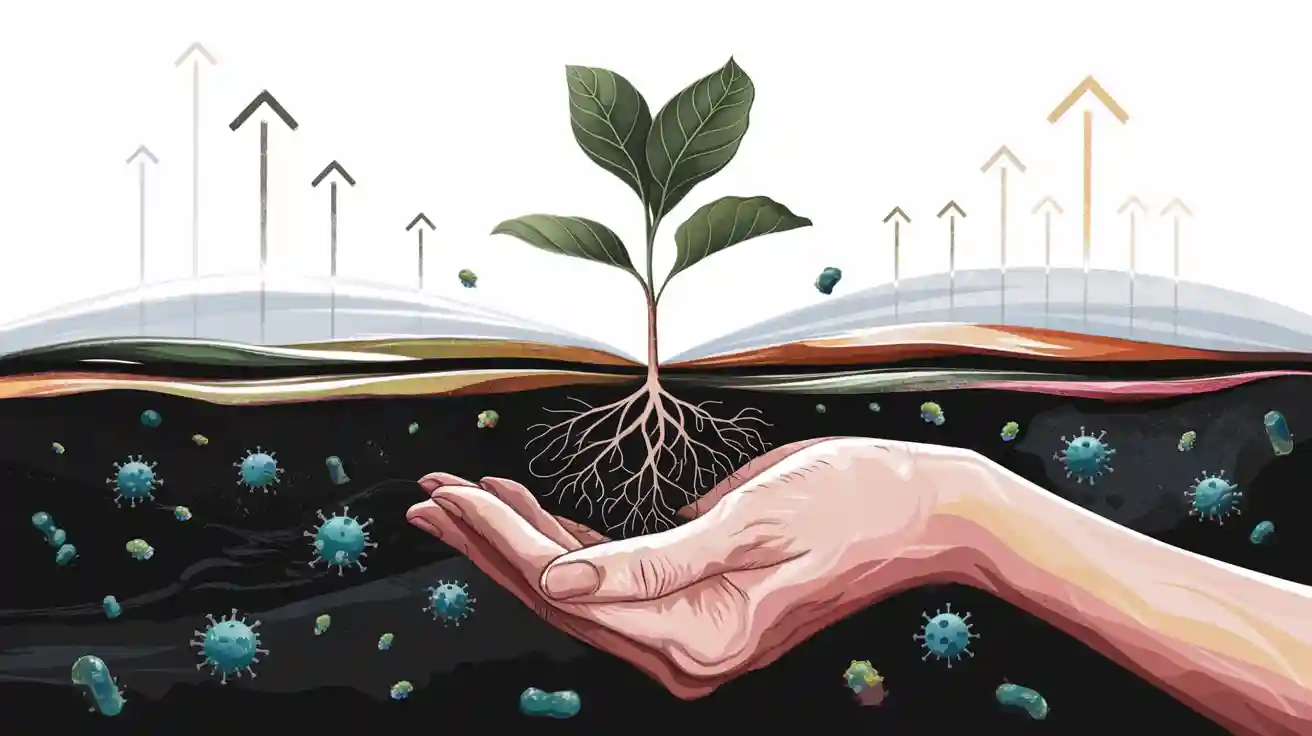
You can change your soil and plant growth by using a humic acid microbial agent mix. This mix works better than just humic acid or just microbial agents. When you use humic acid, your plants take in more nutrients and the soil gets better. Microbial agents make the soil microbes more active, so plants get more nutrients. When you use both, your plants get more nutrients, grow stronger roots, and give you more crops.
Many studies show that humic acid helps soil health by keeping pH balanced, holding more water, and making a healthy soil community. Using humic acid microbial agent mixes also lowers plant disease and helps with sustainable farming.
Key Takeaways
Using humic acid with microbial agents makes soil healthier. It helps plants grow better than using just one. Humic acid helps soil keep water and keeps pH balanced. It also helps good microbes that keep plants safe from disease. Microbial agents add good fungi and bacteria to the soil. These help fix nitrogen, fight bad germs, and make nutrients easier for plants. Using both together makes plant roots stronger and helps plants take in more nutrients. It also helps plants get better after stress like drought or salty soil. This mix makes soil hold more water and lets more air reach roots. It also lowers salt in the soil. Using humic acid and microbial agents can help crops grow more and get taller and stronger. To use them safely, follow the rules for how much to use and how to store them. Wear protection to keep workers and plants safe. Test your soil often and use these at the right time. This helps you get the most benefits for your farm or garden.
Humic Acid Microbial Agent Basics
What Is Humic Acid?
Humic acid is a strong natural material found in soil, peat, and compost. It forms when plants and animals break down over time. Humic acid and fulvic acid are called humates. These acids have large molecules and include different organic acids. Humic acid can dissolve in water if the soil is alkaline, but not if it is acidic. Humic and fulvic acids help soil structure, hold more water, and help nutrients move around.
Humic acid and fulvic acid help plants make hormones like auxin and cytokinin. These hormones help roots grow and let plants take in more nutrients.
Humic and fulvic acids help good microbes grow in the soil and lower the number of bad ones, making the soil healthier.
Humic acid and fulvic acid help soil let water in, let air in, and stick together better. This helps soil keep water and lets roots get air.
Humic and fulvic acids help plants deal with stress, like dry weather or salty soil, by helping balance water and starting helpful enzymes.
Humic acid and fulvic acid help soil enzymes work better, which helps move nutrients and makes soil richer.
Humic acid and fulvic acid also help control soil pH, so plants can use more nutrients. Over time, these acids make soil better, help plants grow, and give you more crops. Humates, which are humic acid and fulvic acid, are very important for healthy soil.
What Are Microbial Agents?
Microbial agents are living things you add to soil to help plants. These include fungi, bacteria, and blue-green algae. Each type has its own job in the soil.
Microbial Agent Type | Examples | Primary Functions |
|---|---|---|
Fungi | Trichoderma spp. | Stop bad germs in soil, act as biofungicides, and make soil better |
Bacteria | Rhizobium, Azotobacter, Azospirillum | Fix nitrogen, move nutrients, make plant hormones, and protect from diseases |
Blue-green algae | Various species | Make soil richer, fix nitrogen, and help move nutrients |
Microbial agents help plants get nutrients, fix nitrogen from the air, and keep roots safe from bad germs. They also make plant hormones and help keep the soil balanced. When you use microbial agents, you help the soil stay healthy and help plants grow well.
Why Combine Them?
When you use humic acid microbial agent mixes, you get more benefits. Humic and fulvic acids make the soil better for good microbes. These acids change roots, help plants use energy, and help plants handle stress. Microbial agents add more life to the soil, help plants get more nutrients, and protect them from disease.
Humic acid and fulvic acid help plants grow by controlling hormones and energy use.
Humic and fulvic acids cause small stress in roots, which helps plants get good bacteria.
These bacteria, helped by humic and fulvic acids, make enzymes and other things that fight bad germs.
When you use humic acid microbial agent mixes, you get stronger roots, better nutrient use, and plants recover from stress faster.
Humic acid microbial agent mixes work together to make soil healthy and balanced. Humic and fulvic acids help good microbes grow, and microbial agents make nutrients easier to get and protect plants. This mix gives you better soil, stronger plants, and more crops. Using humic acid microbial agent mixes gives your soil and plants the best chance to do well.
Synergy in Soil
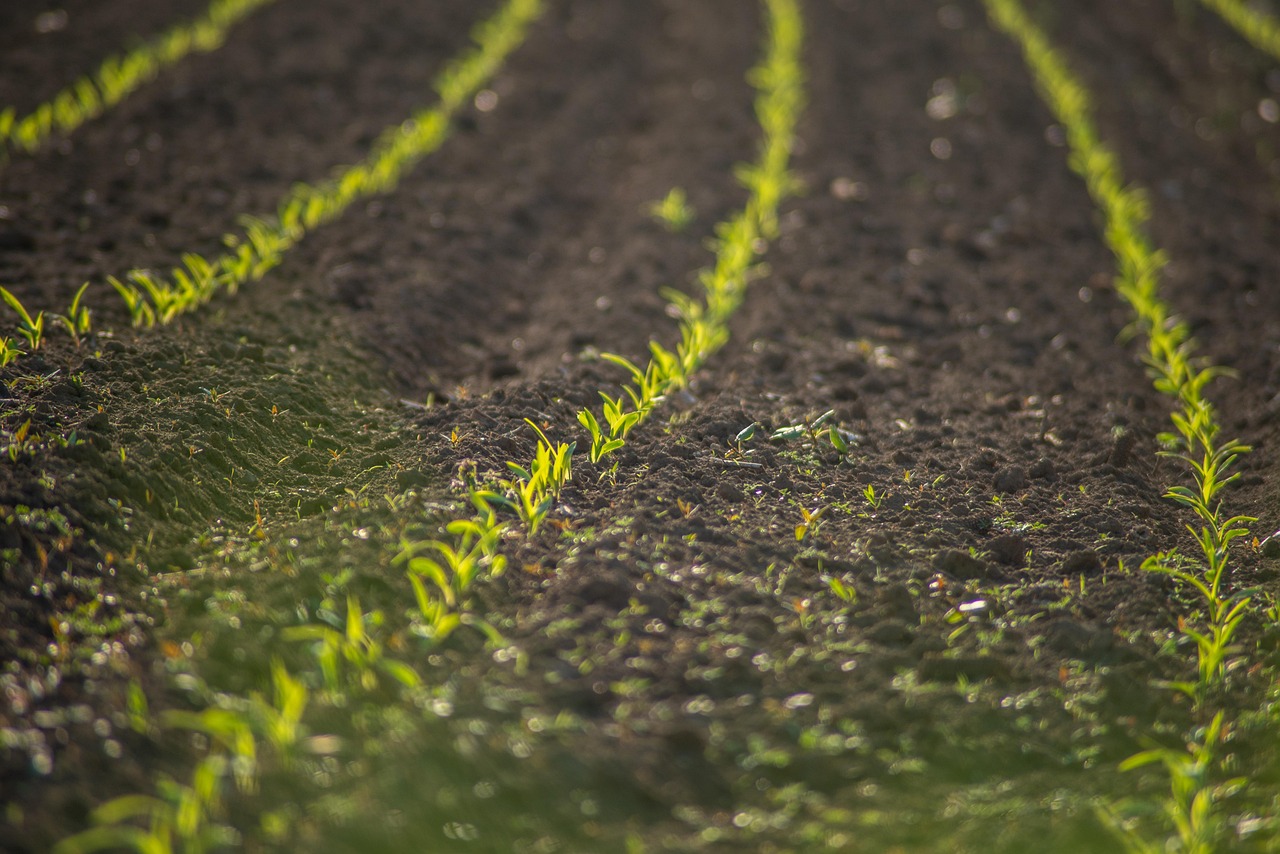
Microbial Activity
When you mix humic acid, fulvic acid, and humates with microbial agents, your soil gets healthier. This mix helps good microbes grow and makes the soil a better place for them. Humic acid and fulvic acid help good bacteria live and grow. These acids also help soil enzymes work well, so plants get more nutrients. You will see more healthy microbes and a stronger soil community.
After 60 days, soil with humic acid and microbial agents had 33.51% more humic acid than soil without them.
Soil enzymes like β-glucosidase and urease worked better, which helped move nutrients and made soil healthier.
The mix made more good bacteria, like Bacillus and Streptomyces, which made the soil stronger.
Earthworms and biochar with humic acid and microbial agents helped more bacteria grow and broke down organic carbon better.
Soil pH and sodium went down, which made the soil better and helped plants grow.
You will find more nitrogen, phosphorus, and potassium in your soil, which helps plants grow strong.
Soil Structure
Humic acid, fulvic acid, and humates help make soil better. When you use them with microbial agents, the soil holds more water and has less salt. This mix helps plants grow taller, with thicker stems and bigger leaves. Better soil helps roots grow and gives you more crops.
Aspect | Effect of Combined Humic Acid (HA), Microbial Agent (M), and Vermicompost (V) Application |
|---|---|
Soil water storage | Went up compared to soil without the mix |
Soil salinity | Went down |
Plant growth parameters | Plants grew taller (+39.2%), stems got thicker (+36.0%), leaves got bigger (+88.1%) |
Photosynthetic characteristics | Plants made more food (+43.9%), let in more air (+97.8%), had more CO2 (+41.1%), lost more water (+133.9%), had more green color (+18.0%) |
Biomass and yield | Plants weighed more (+85.1%), gave more crops (+31.8%) |
Optimal application rates | HA: 120 kg ha-1, M: 60 kg ha-1, V: 120 kg ha-1 |
Correlations | Cotton yield went up with more plant growth, photosynthesis, and water; fiber quality got better with more photosynthesis, water, and yield |
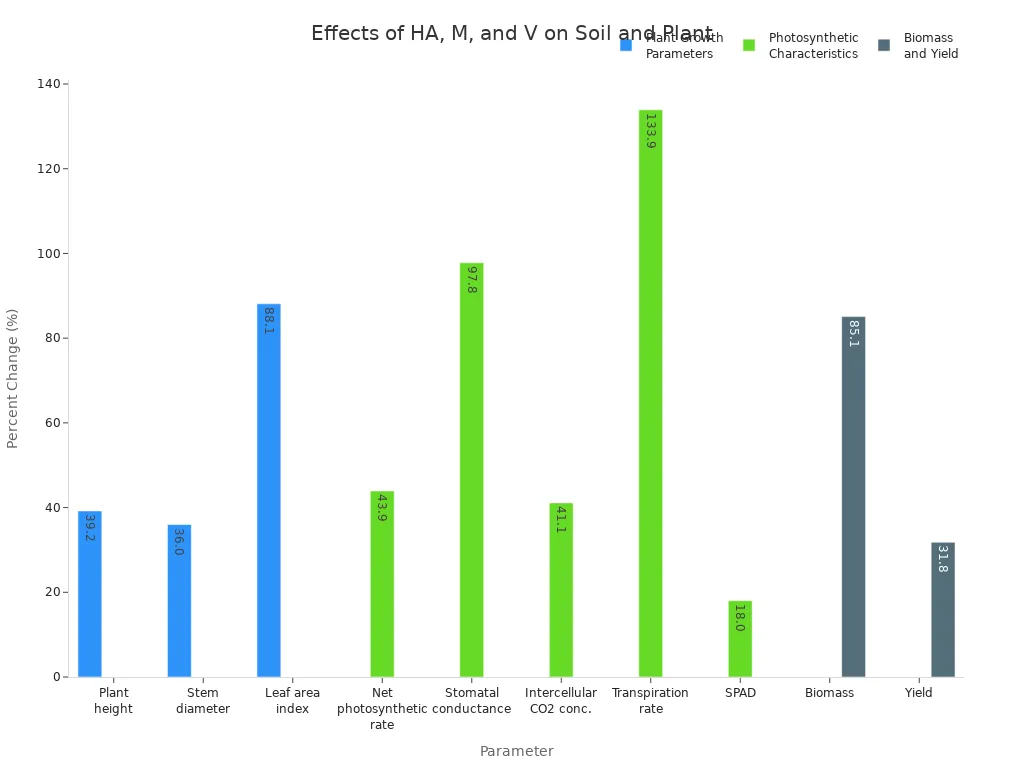
You can see that using humic acid, fulvic acid, and humates with microbial agents makes soil better and helps plants grow. This way, your soil stays healthy and farming is better for the future.
Root Growth
When you use humic acid, fulvic acid, and humates with microbial agents, roots grow stronger. This mix helps roots get longer and have more branches. Roots also work better with good bacteria, so plants get more nutrients and grow faster.
In greenhouses, maize with humic substances and good bacteria had more side roots and more bacteria on them.
Legumes with humic acid and rhizobia had more nodules, took in more nitrogen, and had better roots.
Soybeans with potassium humate and Bradyrhizobium had more nodules and more nitrogen in their shoots.
Humic substances kept good bacteria safe on seeds, so they worked better.
Plants let out more organic acids from roots, which brought in good microbes and made soil better.
Field tests showed this mix gave soybeans more yield, more nodules, and more nitrogen fixing.
Using humic acid, fulvic acid, and humates with microbial agents helps your plants grow strong roots and keeps soil healthy.
Increase Nutrient Uptake
Chelation and Availability
Using humic acid and microbial agents together helps plants get more nutrients. This mix makes it easier for roots to find and use nutrients in the soil. Humic acids work like natural helpers. They grab nutrients and stop them from getting stuck in the soil. Microbial agents break down dead plants and animals. This releases nutrients that plants can use.
Humic acids make soil better and help nutrients move around.
Microbial agents help soil life and make nutrients cycle faster.
Some chelating agents, like EDTA, help plants take in metals but can hurt good soil microbes. EDDS is safer and helps nutrients move without harming the soil.
Using humic acid and microbial agents keeps soil healthy and helps plants get more nutrients.
Tip: Natural and chemical helpers, like microbial agents, make soil more active and healthy. This helps nutrients move and makes it easier for plants to use them.
Plant Absorption
When you use humic acid and microbial agents together, plants can take in more nutrients. This mix helps roots grow stronger and take up more from the soil. Studies show that plants with both humic acid and microbial agents get more nutrients and grow better.
Treatment Type | Key Findings on Nutrient Absorption and Plant Growth |
|---|---|
More phosphorus and nitrogen; better growth than regular compost. | |
Humic Acid Application | Plants grew taller and had more leaves at the best amount. |
Combined Microbial and Nutrient Enrichment | Plants took in more nutrients than the control group; both treatments worked well. |
Microbial Agents on Biochar-Humic Acid Carrier | Both worked together; plants grew better and soil had more nutrients. |
Using both humic acid and microbial agents works better than using just one. Plants get taller, stems get thicker, and roots grow stronger. The soil also holds more nutrients, so plants keep growing well.
Parameter | Improvement Range (%) |
|---|---|
Plant Height | 10.65 – 17.01 |
Stem Thickness | 12.83 – 22.62 |
Dry Weight | 22.6 – 50.25 |
Soil Ammonium Nitrogen | 8.49 – 25.32 |
Soil Nitrate Nitrogen | 10.45 – 22.28 |
Inorganic Phosphorus | 11.69 – 20.11 |
Quick-acting Potassium | 7.95 – 33.01 |
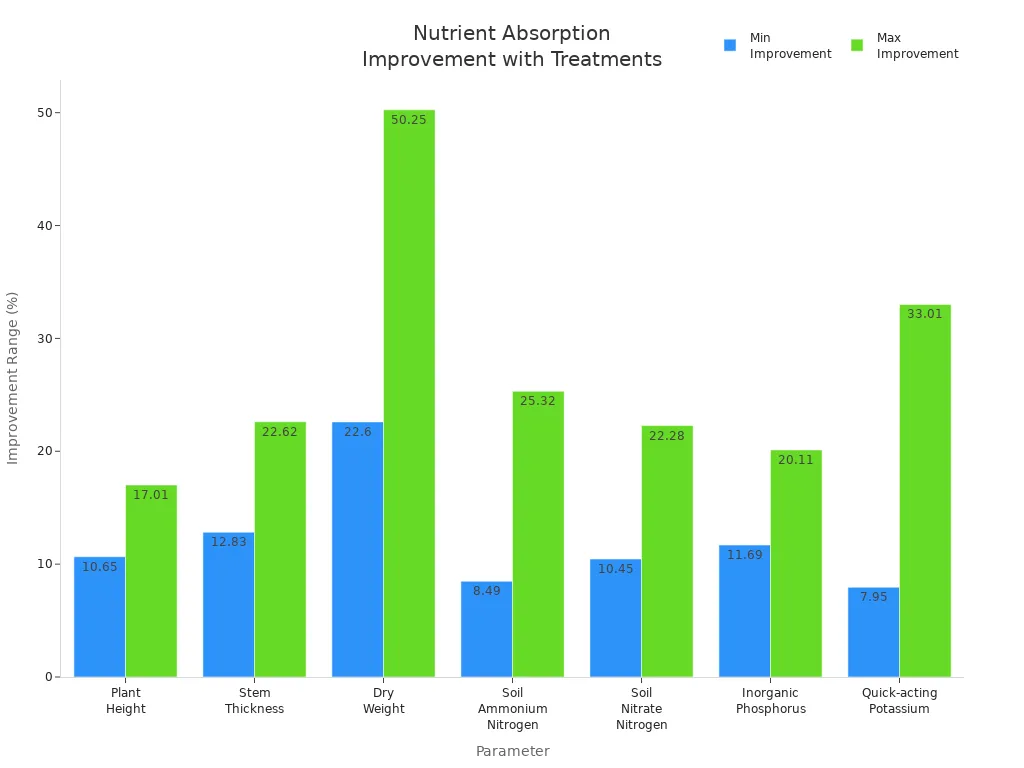
Field tests show these results are true. Sugarcane treated with mixed bacteria took in more nutrients. Raspberries grown with helpful bacteria had more nutrients in their leaves and stems. Maize and barley seedlings with humic substances and microbial agents took in more nitrate and minerals. Roses and soybeans also grew better and took in more nutrients with this mix.
Note: Using humic acid and microbial agents together helps plants take in more nutrients, grow stronger, and give you more crops. This way, your soil stays healthy and your plants do better.
Improve Soil Quality
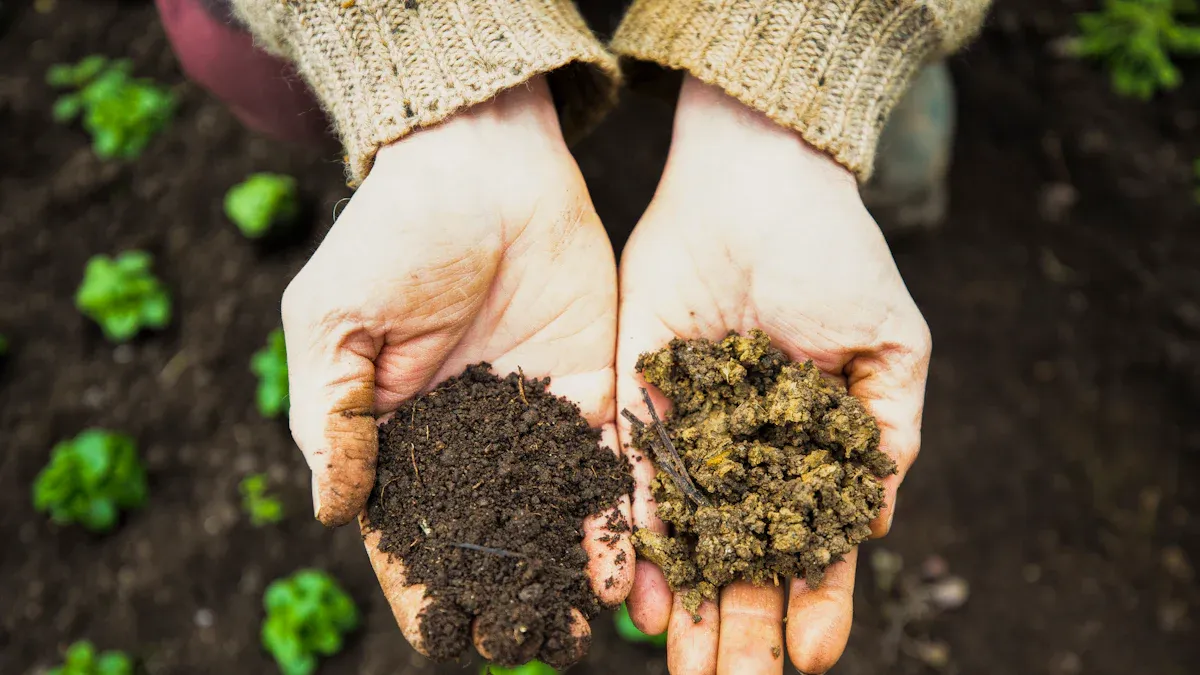
Water Retention
You can help your soil hold more water by using humic acid and microbial agents together. Humic acid and fulvic acid make the soil more stable. This helps water move in and stay for plants to use. When you add humic substances, less water evaporates. Soil particles can keep more water. This means your plants get steady moisture, even when it is dry.
Fulvic acid and humic acid help microbes grow, which helps the soil hold more water.
Better soil and more microbes mean the soil keeps water and plants grow more.
You will see your soil stays wet longer. This helps roots stay healthy and you do not need to water as much. This way, fewer pollutants leave the soil because water and nutrients stay put.
Aeration
Humic acid and fulvic acid help air get into the soil. These acids help soil particles stick together in small groups. This makes the soil less packed and lets more air reach the roots. Studies show that humic acid with biochar-based microbial agents helps soil store more water and have less salt. This also helps air move in the soil.
Humic substances help soil clump together, so air and water move better.
Fulvic acid and humic acid help microbes grow, which makes soil and air flow better.
More air in the soil helps roots grow and take in nutrients, so plants are healthier.
You will notice your soil is lighter and easier to dig. Roots grow deeper and stronger. Plants grow better and can handle problems more easily.
Microbial Balance
Having the right mix of microbes in soil is important for good soil. When you use humic acid and microbial agents, you help good microbes and stop bad ones. Helpful fungi and other good microbes do well with humic and fulvic acids. These microbes help roots grow, let plants take in more nutrients and water, and break down bad stuff in the soil.
Studies show fulvic acid helps bacteria that fix nitrogen, like Ensifer and Blastococcus, grow more. These good bacteria become more common and keep bad microbes away. Using humic acid with biochar also lowers bad germs like Fusarium and helps soil enzymes work better. This means plants grow better, seedlings are bigger, and roots are stronger.
Aspect Evaluated | Findings with Combined Humic and Microbial Agents |
|---|---|
Microbial Diversity | More good fungi and bacteria grow |
Pathogen Suppression | Fewer bad germs like Fusarium |
Soil Enzyme Activity | Enzymes work better, helping plants and nutrients |
Compost and Soil Quality | Soil has more nutrients and is more stable |
When you use humic acid and fulvic acid with microbial agents, your soil gets a good balance of microbes. This teamwork helps plants take in more nutrients and water. Plants are healthier and your soil gets better for a long time.
Increase Crop Yields
Growth Stimulation
You want your crops to grow bigger and faster. Using humic acid and microbial agents together helps plants a lot. This mix makes roots go deeper and shoots get taller. Plants can take in more water and nutrients. This means they grow better and give you more crops.
Scientists saw big changes in many crops with this mix. The table below shows how much more crops you can get:
Crop | Treatment Description | Yield Increase (%) | Additional Benefits |
|---|---|---|---|
Maize | Foliar spray of humic acid + diazotrophic endophytic bacteria | Up to 65 | Works well in poor soils and during drought; root biomass also increased |
Sugarcane | Biostimulant with potassium humate + beneficial bacteria applied after emergence | 18–37 | More stems, better drought resistance, stronger antioxidant activity, improved water use |
Tomato | Substrate biofortification + foliar humic acid + plant growth promoting bacteria | Not quantified | Better seedling development, more fruit, higher disease resistance, more nitrogen-fixing bacteria |
Pineapple | Humic acid + Burkholderia spp. during acclimatization | Shoot: 147%, Root: 105% | Higher shoot and root growth, more nutrients (N, P, K) during critical early stages |
When you use this method, your crops can do their best. You will see more leaves, thicker stems, and bigger roots. These changes help you get more crops at harvest.
This mix works even when things are hard. Maize and sugarcane grew well in poor soil and dry weather. Tomatoes and pineapples had stronger roots and shoots. This helped them live and grow after being moved.
Stress Resistance
Crops have to deal with things like dry weather, salty soil, and disease. You can help your plants by using humic acid and microbial agents together. This mix makes crops stronger and keeps them healthy when things get tough.
The table below shows how this mix helps plants fight stress:
Aspect | How the Combination Helps |
|---|---|
Nutrient Uptake | Plants take in more nutrients, which helps them stay strong during stress |
Antioxidant Enzyme Activity | Higher enzyme activity protects plants from damage caused by drought or salt |
Root Development | Stronger roots help plants find water and nutrients even in poor soil |
Microbial Support | Good microbes help plants grow and fight off disease |
Improved Bioactivity | Microbes change humic acid to make it work better, helping plants recover from stress |
Synergistic Effects in Studies | Barley and maize grew better under salty conditions, with higher yields and less cell damage |
Note: Humic acid and microbial agents help crops live through drought and salty soil. Your plants keep growing, even when others do not.
You also help keep your soil healthy. Good microbes and humic acid work together to protect roots. They help plants get better after stress. This teamwork lets crops handle bad weather, poor soil, and disease much better.
You want more crops and stronger plants. Using humic acid and microbial agents together gives your crops the best chance to grow, make more food, and stay healthy all season.
Application and Compatibility
How to Apply
There are many ways to use humic acid and microbial agents. Each way helps your plants and soil. You can pick the best way for your needs:
Soil Amendments: Put humic and fulvic acids right into the soil. This makes soil better, helps it hold water, and moves nutrients to roots. It also wakes up microbes, so dead plants break down faster.
Foliar Sprays: Spray fulvic acids on leaves. This helps plants get micronutrients fast, especially if they are missing some.
Seed Treatments: Cover seeds with humic acid before planting. This helps seeds sprout, roots grow, and seedlings get strong.
Integration with Fertilizer Programs: Mix humic substances with your normal fertilizers. This helps plants take in more nutrients, like phosphorus, and makes fertilizer work better.
Choose the Right Concentration: Use humic acid at the right amount, usually 0.005% to 0.01%. Using too much or too little does not work as well.
Compatibility: Most humic products work with dry fertilizers and other chemicals. Tests show there are no big problems mixing them.
Tip: Humic acid is food for good microbes. Using both together makes soil healthier and helps it keep water.
Safety and Tips
You need to be safe when using humic acid and microbial agents. These steps keep you, your workers, and your crops safe:
Always use Good Microbiological Practice (GMP) when making, storing, and using these products. This keeps out bad germs.
Teach everyone about what is in the product, health risks, and how to use it safely.
Do not breathe in dust or spray from microbial agents. Wear gloves and goggles to protect your skin and eyes.
Make sure all microbial agents are safe from germs like Salmonella and E. coli.
Only use products made in safe, controlled places. Stay away from those made in open air, which can have bad microbes.
Tell everyone about how humic acid and microbial agents are made and used.
To get the best results, follow these tips:
Test your soil before using humic acid. This tells you what your soil needs.
Pick the right kind of humic or fulvic acid for your soil and plants.
Use it at the right time, like when planting, and follow the label.
Mix humic acid into the soil, not just on top.
Check your soil and plants often. Change how you use it if you see problems.
Use humic acid with good care, like watering and mowing.
Do not skip soil tests or use too much. Both can cause problems.
Note: Humic acids from nature are okay for organic farming. Always check your product meets organic rules if you farm this way.
If you follow these steps, your soil and plants will do well. Your farm or garden will stay safe and give you good crops.
You can change your soil by using humic acid and microbial agents together. This mix helps the soil have more nutrients and makes plants grow better. It also helps crops give you more food. Studies show humic acid helps good microbes, makes soil stronger, and helps get rid of bad things. Farmers say their plants grow better and their soil is safer and gives more crops. You get healthier plants and better soil for a long time. Try this way to see good changes in your garden or farm. For more help, look at trusted guides about soil health and ways to farm that last.
FAQ
What is the best time to apply humic acid and microbial agents?
It is best to use them when you plant seeds or when plants are small. This helps roots grow and helps good microbes start working. You can also use them if your plants are stressed to help them get better.
Can I use humic acid and microbial agents in organic farming?
Yes, you can use natural humic acids and approved microbial agents in organic farming. Always make sure your products are allowed for organic use before you use them.
How often should I reapply these products?
You should use them again every 4 to 6 weeks while plants are growing. The type of soil, what your plants need, and the weather can change how often you use them. Always read the label and follow the directions for best results.
Will humic acid and microbial agents work in all soil types?
You can use them in almost any soil. Sandy soil holds more water with these products. Clay soil gets more air and is less packed. Test your soil first so you know how much to use for your land.
Are there any risks to overusing humic acid or microbial agents?
Yes, using too much can cause problems with nutrients or waste your money. Always use the amount the label says. Using more does not always help your soil or plants.
Can I mix humic acid and microbial agents with fertilizers?
You can mix most humic acids and microbial agents with fertilizers. Always check the label to make sure they work together. Some chemicals can hurt good microbes.
How do I store humic acid and microbial agent products?
Keep these products in a cool, dry place. Close the containers tight and keep them out of the sun. Storing them right keeps the microbes alive and humic acids working well.
Do humic acid and microbial agents help with plant disease?
Yes, they help good microbes that fight bad germs in the soil. Healthy soil and roots help plants stay strong against disease. You still need to watch for bugs and plant sickness.
See Also
Advantages Of Using Humic And Fulvic Acids For Growth
Identifying Plants That Thrive With Humic Acid Application
Comparing Humic Acid And Chemical Fertilizers For Sustainability
